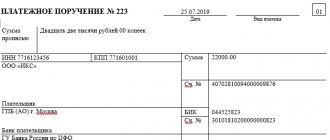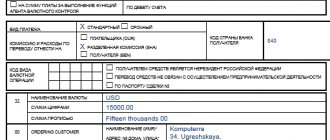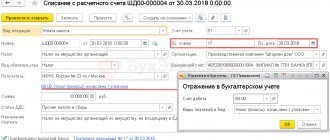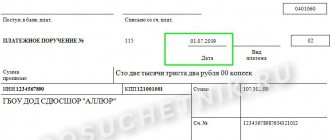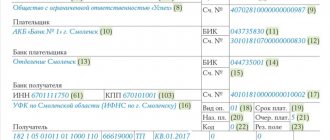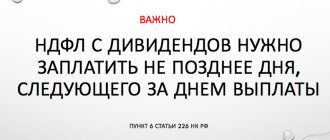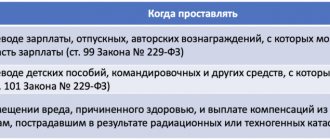Field 110 in the payment order
Today, one of the dominant types of non-cash payments in the Russian Federation is the execution of a payment order. But, despite their widespread use, when creating payment slips, questions often arise regarding the correct filling out of the document fields. Especially often, legislators change the requirements for the provision of information positioning the status of the payee and the payment direction factor. This is detail 110 in the payment order. Let's talk about the features of filling it out in 2018.
Payment order: payment type in field 110
Code 110 in a payment order indicates the type of payment and is located in the recipient information block. Please note that the requirements of the Central Bank of the Russian Federation for the design of this field change quite often. It seems that this is due not only to interdepartmental disagreements and imperfect legislative norms, but also to the development of technology.
Thus, the Ministry of Finance of the Russian Federation, by order No. 126n dated October 30, 2014, canceled filling out line 110 of the payment order from 2015, but practically at the same time, the Central Bank of the Russian Federation notes the need to fill out this field and in letter No. 234-T dated December 30, 2014, establishes the obligation to enter O.
Further, the Central Bank of the Russian Federation, by instruction No. 3844-U dated November 6, 2015, changed the previous order by canceling the completion of field 110 in the payment order for everyone without exception. These changes were effective from March 28, 2016.
The situation changed last year. Directive of the Central Bank of the Russian Federation dated July 5, 2017 No. 4449-U introduced new changes to regulation No. 383-P concerning the rules for transferring money. They began to operate on 08/08/2017. We will explain the reasons for the next adjustment and tell you which payments they will affect.
The Bank of Russia had to update the requirements for filling out this field due to the adoption of a new version of the Law “On the National Payment System” No. 161-FZ dated June 27, 2011. In essence, the changes under consideration were the result of the deployment of a state program to introduce domestic payment systems, the advantage of which is independence from foreign instruments and sanctions.
General provisions about the document
The payment order form, like all other forms of documents used to make payments, was prepared and approved by the Central Bank of the Russian Federation in Regulation No. 383-P dated June 19, 2012. It also presents the methodology by which the document is filled out, and Appendix No. 3 contains its approved form indicating numbered fields for ease of completion.
We will not list all the payment details, since for our publication only field 110 is of particular interest. in the 2018 payment order , or more precisely in the Central Bank’s requirements for filling it out, since the latest adjustments were approved quite recently - in August 2017. Let’s look at the vicissitudes of completing this detail.
Consequences of incorrectly indicating the type of payment being made
If an error is made in the value of detail 1101 in the payment order, the money may not be transferred, and the payments may be returned to the sender. There are several examples of such cases:
- Any mark that is placed in the “type of payment being made” column for a transfer, which is not urgent according to any criterion and in relation to which it was not planned to apply BESP.
- When transferring money via BESP, the “type of payment” column contains a code or word that differs from “urgent”.
The consequence of this may be that the tax inspectorate recognizes the arrears as a responsibility to the budget. The basis for this will be the Tax Code of the Russian Federation.
Similar articles
- Order of payment in a payment order
- Field 107 in the payment order
- How to indicate the type of payment in a payment order?
- Unique payment identifier
- Payment order fields
Payment order: field 110 in 2021
Filling out detail 110 today is provided only in cases where the payment is addressed to an individual, and he receives funds from the country’s budget. Such payments are considered:
- Salary/salary/remuneration/ of government employees;
- Remuneration of personnel of state institutions, municipal organizations, as well as state extra-budgetary funds;
- State scholarships;
- Pensions, compensation and other social payments from the Pension Fund;
- Lifetime imprisonment for judges.
If the payment falls under any of the categories indicated in the list, then the type of payment in the 2021 payment order in field 110 o. It is quite possible that over time this list will expand, since Law No. 161-FZ does not exclude such a possibility.
When making other payments, the rule still applies - field 110 in the payment order is not filled in. This is true even for:
- Mandatory transfers to the treasury;
- Settlements made by companies, entrepreneurs and individuals.
So, filling out line 110 in a payment order in 2021 has so far become mandatory only for transactions involving the transfer of money to individuals from budget funds.
Purposes of specifying the type of payment to be made
Why is it necessary to indicate the type of payment being made on the payment slip? It is used to identify the method of transferring money. Currently, money can be transferred to the recipient’s account using one of three methods:
- By post;
- By telegraph;
- Through the BESP system.
If telegraph is used, the payment made is automatically recognized as urgent. Other criteria for classifying a payment into the “urgent” group are:
- Transfer of a payment document via telecommunications channels;
- Entering field 110 in the payment slip.
If the payment does not necessarily need to be completed urgently, you do not need to enter anything in this field.
Another purpose for which you need to indicate the type of payment being made is to check the sufficiency of the balance of money on the account of the counterparty. According to the requirements of Regulation No. 384-P, such a check must be carried out on all payments received by the bank if column 110 of the payment order is marked “urgent”.
New details have been added to the payment
The Bank of Russia issued Directive No. 4449-U dated July 5, 2021, which amended Bank of Russia Regulation No. 383-P dated June 19, 2012 “On the rules for transferring funds.” Such changes are necessary for bankers in order to monitor compliance with the law’s requirement for non-cash payments from the budget only to Mir cards. Now, when transferring funds in favor of individuals at the expense of budget funds, senders will have to fill out field 110 of the payment order. Until now, this field has remained empty.
Filling out field 110 in the payment slip
If you are transferring budget funds, you must enter the number “1” in this field. This code will tell the recipient's bank to check whether the account owner has an issued Mir payment card. For regular transfers at the expense of the organization’s own funds, field 110 still does not need to be filled in.
If during the verification it turns out that the recipient has a Mir card attached to his bank account, or that any issued payment card is missing, the recipient’s bank must credit him with the payment amount. If the recipient does not have a Mir card, the bank reflects the payment amount in the account for accounting for amounts of unknown purpose. After this, the bank must, no later than the next business day, send a notice to the recipient of the funds with an offer to appear within ten working days to receive the payment amount in cash.
In addition, the recipient can submit an order to the bank to credit the payment amount to a bank account that provides for transactions using the Mir card. If within these 10 days the citizen does not receive his money or does not provide an order for transfer to another suitable account, then the bank must return it to the payer.
New details in payments
The Central Bank has introduced new details into the payment order. Field 110, which has not been filled in recently, will indicate the payment code.
It will be filled out when transferring funds to individuals at the expense of budget funds. For regular payments, at the expense of organizations’ own funds, this field will not be filled in.
Directive of the Central Bank of the Russian Federation dated July 5, 2021 No. 4449-U required that non-cash payments from the budget be made only to Mir cards. When transferring budget money, the sender will have to put the number “1” in this field. And this will be a signal to the recipient’s bank to check whether the account owner has an issued Mir payment card.
If the recipient does not have a Mir card, the bank reflects the payment amount in the account for accounting for amounts of unknown purpose. And no later than the next day, sends a notice with a proposal to appear within no later than 10 working days to receive the payment amount in cash or submit an order to credit the amount to another account.
If within ten days an individual does not appear to receive cash or does not provide an order for transfer to another suitable account, the funds will be returned to the payer.
Such rules are established for recipients of pensions, salaries of civil servants and other public sector employees, government scholarships and the monthly lifelong allowance of judges.
New order
Appendix No. 13 has been added to Central Bank Regulation No. 383-P. It regulates the execution and control by banks of orders on the basis of which the above budget funds are paid.
The main tasks of the credit institution in this case:
- provide state employees with national payment instruments;
- credit payments to the accounts of public sector employees when they use national payment instruments.
The mechanism is like this. According to the order that came to the bank, a certain amount of money is addressed to the state employee (see the list above) and the code “1” is indicated in field 110. The recipient's bank immediately checks the presence of an issued payment card in its account, which relates to national payment instruments under Law No. 161-FZ.
Whether there is such a card or not, the bank still credits budget money to the account specified in the order.
If there is no domestic payment card on the account, the bank reflects the payment amount as an unknown purpose. The law gives 1 working day for the bank to send a notice to the public sector employee in a manner agreed upon with it with a proposal within up to 10 working days from the date of receipt of the order with code “1” in field “110”:
- come to receive money in cash;
- or submit an order to credit the amount to an account that provides for transactions using a domestic payment instrument, or to an account that does not provide for transactions using a payment card.
If the state employee does not react in any way within the specified 10 days, the bank returns the due amount to the person on the 11th working day. At the same time, in the order in the “Purpose of payment” details, the bank indicates that the return occurred due to non-compliance with Part 5 of Art. 30.5 of Law No. 161-FZ. State employees will also receive a similar notification.
Read also
02.08.2017
Explanation in field 110
For the beneficiary's bank, column code 110 will indicate the purpose and type of payment. It is used to decipher banking transactions for non-cash transfers of mandatory insurance and tax contributions to the budget. Subject to the new rules, each individual entrepreneur, legal entity or individual entrepreneur must leave field cell 110 in the payment form empty. Based on the regulations of the Central Bank of the Russian Federation - enter “0”. The double explanation does not add to the understanding of how to proceed when paying taxes and filling out a financial order. Read on to find out where to find the required line and how to fill it out.
Filling out field 110 - legal explanation
The generally accepted type of payment order used when transferring tax payments was developed on the basis of the regulation of the Central Bank of the Russian Federation dated June 19, 2012 No. 383-P. The document described in detail the specifics of entering information into its columns, including line 110. The field was filled in only in case of transfer of funds to budgetary areas. The instructions for entering data in the “type of payment” column were as follows:
- “PE” - when transferring late payments and penalties for mandatory payments;
- “PC” - when transferring interest;
- “0” – tax payments coming from the Federal Tax Service.
The instructions for drawing up payment order columns change frequently. Therefore, you need to monitor the release of updated instructions. It often happens that legislation issued by different departments contradicts each other. By Order of the Ministry of Finance of October 30, 2014 No. 126n, the need to fill out line 110 of the payment order was abolished. Based on this document, it should remain empty. It was recommended to move information about the type of payment to field 109.
The response to this was the letter of the Central Bank of the Russian Federation dated December 30, 2014 No. 234-T, which explained that in column 110 the number “0” should be entered. A year later, on November 6, 2015, by decree No. 3844-U of the above-mentioned government agency, this decision was canceled. It feels like everything is back to normal. Disagreements regarding the formation of payment order lines have been eliminated.
In July 2021, a new resolution of the Central Bank of the Russian Federation No. 4449-U was issued, which makes adjustments to the previous provision on making non-cash transfers and the formation of orders. The changes took effect on August 8, 2021. They were justified by the restructuring of the general payment system of the Russian Federation and the country's transition to its own independent settlement system MIR.
Currently, the mandatory fields for filling out the payment order are cells 101 to 109, 110 is empty. State institutions receive information about the purpose of the payment on the basis of the KBK, for which line 104 is reserved. An erroneous code in this section of the payment will not allow the payment to be processed correctly. The funds may simply get stuck in the bank's system. The sample for filling out field 110 in a payment order will not be any different from 2021. The latest innovations regarding filling out line 110 are dated August 2021.
When is it necessary to fill out field 110?
Filling out detail 110 in the payment order depends on the type of payments, the transfer of which is formalized by such a financial document. It is necessary to enter information in field 104 together with cell 110 of the payment order when:
- Wages and remuneration are paid to employees of enterprises owned by the state.
- Payments are being made to government employees.
- Beneficiaries receive pensions, benefits or compensation from the Pension Fund.
- Scholarships are provided to young promising specialists.
- Documents are being drawn up to pay the lifelong salaries of judges.
For all other payments, including transfers of legal entities and individual entrepreneurs by bank transfer and payment of mandatory contributions to the budget, the method of entering information in column 110 does not change. The field must remain empty, without dashes or numbers.
Code “1” in field 110 when making non-cash transfers from budgetary structures means that money can only be credited to accounts to which a MIR debit card is attached. If the bank client does not have such a means of payment, his actions should be as follows:
- After the money arrives at the bank, it will be detained in the company’s accounts until the circumstances of the transfer are clarified.
- The next day, the recipient will be sent a notification with a requirement to visit a bank branch within 10 business days to receive the transfer amount in cash using their passport.
- If the client has another account through which it is possible to carry out monetary transactions using the MIR card, information on its details must be provided to the bank employee.
- After the ten-day period, if the recipient specified in the financial order has not visited the bank and provided new account information, the funds will be transferred back to the sender.
Instructions for filling out a payment order to pay insurance premiums to the Social Insurance Fund.
Please note that this instruction applies ONLY to filling out a payment order to pay insurance premiums to the Social Insurance Fund. For other payments please refer to the relevant instructions.
Unfortunately, the software for processing electronic payments varies from bank to bank; it is not possible to provide instructions for detailed work in each of these programs. But despite their differences, they all form a standardized printed form of the payment order, which allows you to check the correctness of filling out the document before sending it to the bank for payment, and correct possible errors.
A sample payment order of a LEGAL ENTITY for payment of insurance premiums to the Social Insurance Fund should look like this (everything that is highlighted in dark red does not apply to the payment order and is drawn solely for the purpose of explanation)
Recipient, recipient's bank, BIC of the recipient's bank, current account for all payers in Moscow - the same for all companies registered in Moscow.
Field 101 – indicator of taxpayer status –
08
Field 104 – budget classification code – 39310202050071000160
–
for 2015
Field 105 – OKTMO code
(territorial municipality code) at the place of registration of your company
-
information is filled in from a document issued to your company by the Statregister of Rosstat, Moscow.
Field 106 – basis of payment –
TP – current year payments
Field 107 – tax period
– the period is indicated - a quarter (then the CV is written) or a month (then the MS is indicated), then the number of the period (the number of the quarter or month) for which the tax payment is made and the year. All fields are separated by dots. For example:
- When paying for the 4th quarter of 2014, you should indicate KV.04.2014
- And when paying for the month of February 2015, you should write MS.02.2015
Field 108 - No. of the payment basis document
— 0 or the date of the document – for example, a requirement (if such a requirement was received by your company).
Field 109 – Document date
– date of declaration or date of demand (if such a demand was received by your company).
Field 110 – Payment type –
from 01/01/2015 it is not filled in or takes the value 0
Field 22 – UIN code – 0
In the payment order there is always a field “Purpose of payment”, which must be filled in with the following text: “Payment of insurance contributions to the Social Insurance Fund for the National Insurance Fund for (indicate the month and year for which contributions are paid) Registration number (indicate a 10-digit registration number of your company in the Federal Tax Service, assigned upon registration).
What payments do banks accept?
Not only are tax agents confused with the method of filling out field 110, but bank employees also do not have clear instructions on which payments to accept. Some employees make payments using documents with “0” in field 110. Others, citing the law, require that the field be left blank or have a space in it. But for some there is no difference.
In order for the execution of a financial order to be carried out in accordance with all the rules, and for the money to reach the recipient on time, you should adapt to the requirements for payment documents and field 110 established by the bank servicing the enterprise.

